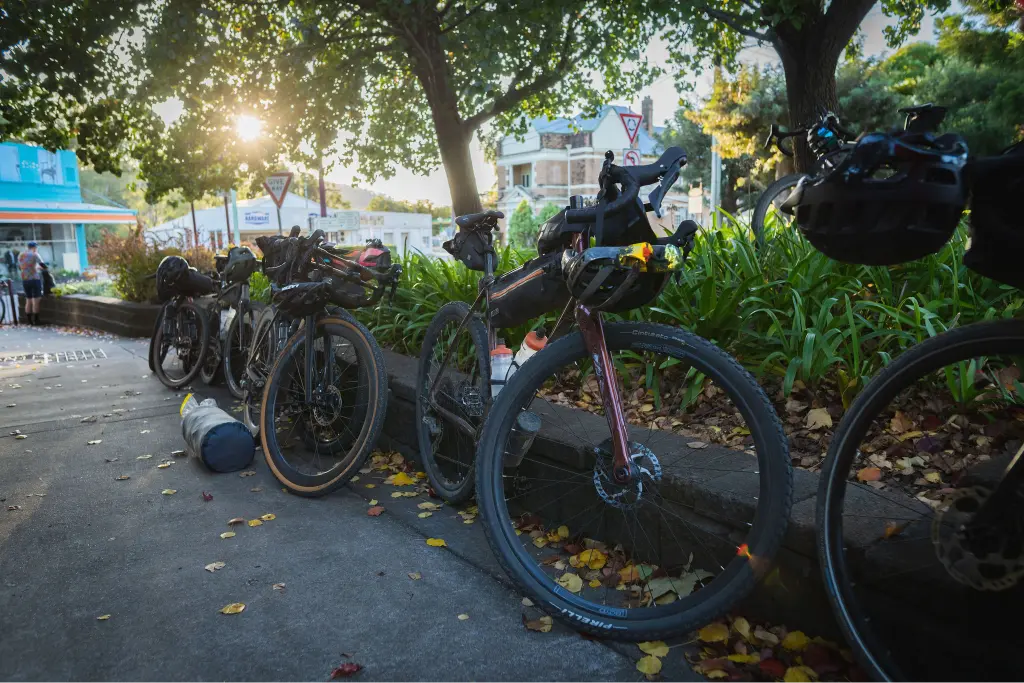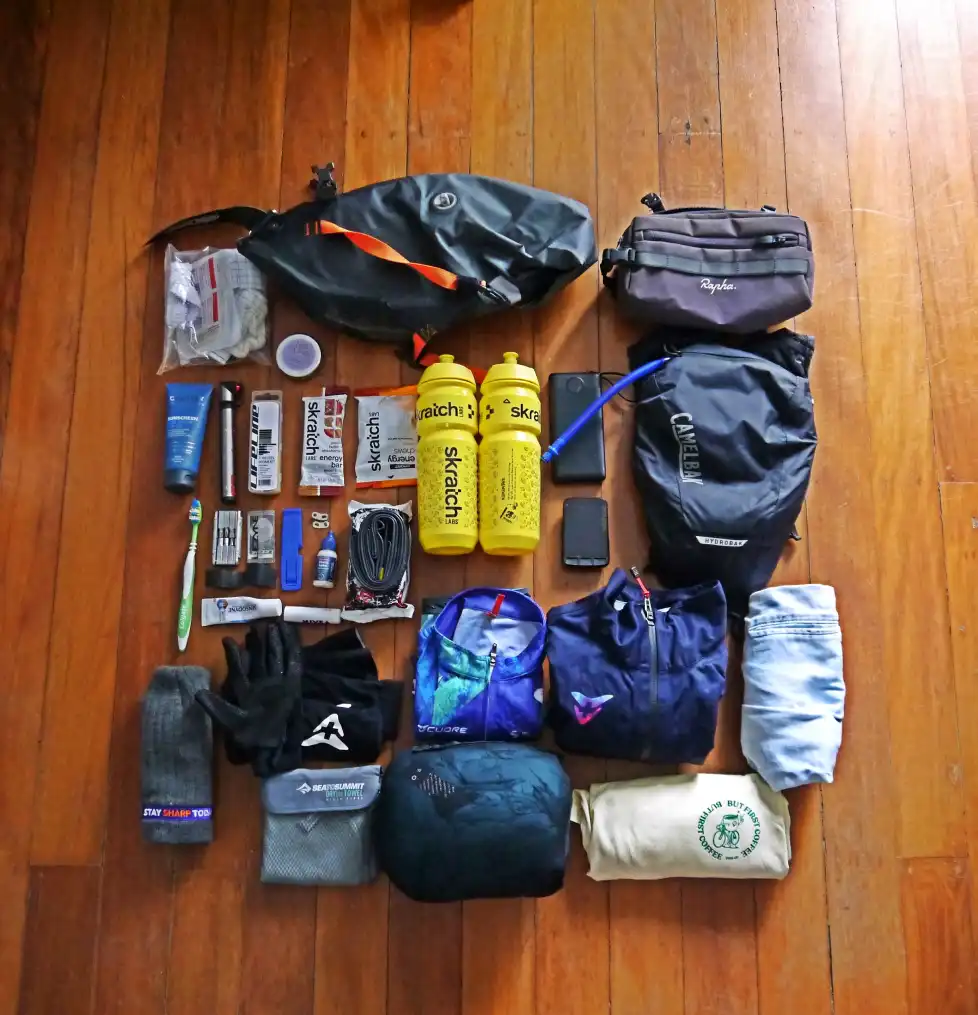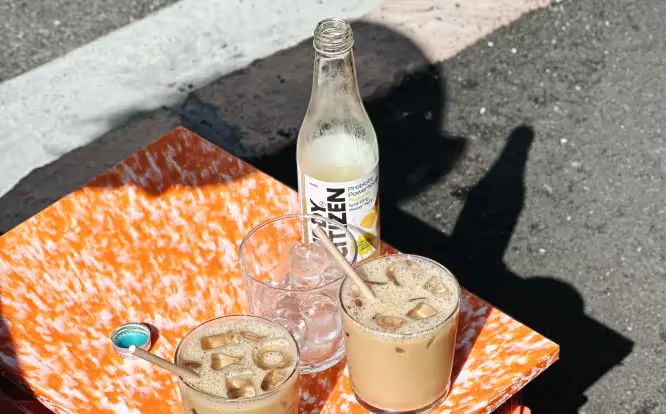What to Pack for Your First Bikepacking Trip
What is Bikepacking?
I was first introduced to bike packing in 2021 at Graveleur’s Thunderbolts Adventure: an overnight bike packing trip through the Gloucester region in NSW. At the time bike packing was a new and exciting emerging genre of the sport and it was hard to wrap my head around it. I had to carry everything with me? How do I do that? What sort of bike do I need? How heavy would that make my bike? I learnt quickly in the lead-up to the event that the fundamentals of bike packing are an overnight or multi-day adventure on backcountry roads. It’s about immersing yourself in nature, finding beautiful roads, often off-road with a blend of gravel and dirt, and practising the principles of minimalism: carrying only what you need and being self-supported.
At Thunderbolts Adventure it was fun to look at the variety of bikes, gear, and clothing that everyone chose to use. There are no rules for bike packing. Forget the Velominati: while most opt for gravel bikes due to their lighter weight, appropriate gearing, and compatibility with bike packing accessories – there’s a plethora of setups that can be found at any bike packing or gravel event. If it gets you from A to B you can ride it. It’s fascinating to look at everyone’s chosen setup: road bikes, mountain bikes, gravel bikes, to 650b wheels, whacky handlebars with flared bars, gravel forks, bags, and contraptions of all sorts that can carry your gear in whichever way imaginable. Each year brands are bringing out more innovative, lightweight inventions that offer creative solutions for bike packing. Keeping up with the latest gear and planning your setup is a hobby in itself, as is sitting at the café debating the pros and cons of accessories and mounts with fellow enthusiasts. After ten years of racing in the sport at a high level, I thought I had a pretty good understanding of cycling; this was a whole different world!
It can be easy to be overwhelmed with understanding what to pack, and how to carry it, for your first bike-packing adventure. In my mind there are two streams of bike packing: one where are fully self-supported/off-grid and the second where you ride but rely on local eateries and accommodations along the way.
I’d highly recommend the second option to start with. It means you don’t need to pack a tent, sleeping bag, pillow, sleeping mat, cooking kit, food, and coffee maker (if you’re as addicted as I am).
A ride like the Thunderbolts Adventure is ideal as it’s a gateway into bike packing: whilst you do need to carry everything with you and it’s largely self-supported, Graveleur will transport your tent to the overnight stop and provide dinner/breakfast. You even get a water/feed station stop midway, mechanical support, and the option of hiring a tent if you’re organised.
For a basic bike packing trip, you should be able to fit your gear in a rear saddlebag, handlebar bag, and frame bag. Even consider a lightweight hydration pack for more storage or water capacity.

My Essentials Guide for a Basic Bike Packing Trip
- Food/Water: Plan your route to include stops in local towns for refuelling to reduce the amount of food and water you need to carry with you. I like to plan a stop every 2-3 hours. Make sure to carry enough riding food for remote areas and ensure you have adequate water capacity on your bike, preferably at least 3L. For food, aim to eat at least 60g/carbs per hour to get you through the day without the dreaded ‘bonk’. 60g is the equivalent of one and a half hot cross buns, three bananas, or a peanut butter sandwich. It’s not a race so stops at pubs for lunch are mandatory!
- Repairs and Spares: it goes without saying, but make sure your bike has had a service before your trip. Pack essentials for basic mechanical repairs and most importantly, learn how to use them including a mini-pump, co2, spare tubes, chain lube, tyre plugs (if running tubeless), tyre boots, patch kits, tyre levers, multi-tool, chain breaker, and spare chain link. It’s also helpful to pack a lightweight bike lock that you can use to lock your bike while you run into shops for food or cafes along the way.
- Clothing & Layers: wear your cycling clothing e.g. jersey, bibs, shoes, sunglasses, gloves, and helmet. Packable layers are essential for covering all seasons: arm/leg warmers, rain jacket, and gilet. Also, include off-bike outfits suitable for the season, such as lightweight puffer jackets, shorts/pants, shirts, socks, sandals, and a beanie. You may want to pack a lightweight pair of shoes to wear off the bike, or if you’re comfortable wearing your MTB shoes around town – just wear those.
- Toiletries: toothbrush/paste, sunscreen, SPF lip balm, hairbrush.
- Electronics: cycling computer/GPS head unit with maps, phone and charger/battery bank.
- Safety: it’s best practice to carry a first aid kit comprising at a minimum: a safety blanket, compression bandage for snake bites, triangular bandage, pain relievers, disinfectant, and dressings. Look into hiring an EPIRB for remote ventures and make sure you’ve got bike lights for visibility.

After Thunderbolts I had really caught the bike packing bug and my friend and I did a trip from Cairns airport, to the Atherton Tablelands, to Port Douglas and back again. We flew in, stored our bike bags in a locker at the airport, and then set out directly from the airport for a week of riding, stopping at friends or hostels along the way. In a warm, temperate climate, you really don’t need much. And if you spend all day on your bike exploring backcountry roads, stopping at Waterfalls, and going for swims at water holes – at the end of the day all you really need is a large hearty meal and bed. And maybe a ginger beer (or two).

I’m a minimalist at heart. It doesn’t come as naturally to my friend Georgie. Over 400 kms of riding, she carried around a 1L container of hair conditioner (apparently it was on special?!) and a 300-page book which she only read on the plane, at the end of the trip! To her credit, she didn’t complain about the extra weight! The key to bike packing is packing the bare minimum. Pack small/light and don’t be afraid to handwash your kit in the hotel room to wear the next day, if it means saving on space in your saddle bag. It’s a gratifying experience to embark on a bike-packing trip, to explore nature and to be fully self-sufficient. I can highly recommend it for your next cycling adventure.
Make sure you’re totally covered against things that might happen when you’re out riding. If you need insurance, we’ve got this! Get your Bicycle Insurance Policy & let’s ride! Thanks to Velosure, your bike will be covered against theft, accidental damage and travel.










